Conventional nutrient guidelines: explaining what I mean by "broken"
This is no secret among turfgrass scientists—there isn’t a lot of good justification to support what we call conventional guidelines for soil nutrients in turfgrass. And by that, I mean the conventional guidelines are broken.
I’ll explain it by taking a quick look at data from the first year1 of the Global Soil Survey. But first, you might like to have a look at these for some background.
Background info
In a 2013 GCSAA webcast on putting green nutrient use and requirements, I explained that conventional guidelines are broken because they “tend to recommend fertilizer additions when we do not see any benefit to the turfgrass.”
In this analysis of soil test potassium, and a comparison of the soil test levels to the actual amount of potassium fertilizer required to increase the soil to the guideline recommendation, it became apparent that “conventional soil test guidelines are sometimes just impossible to reach.”
The logic of this approach is summed up by Wayne Kussow, who wrote that “applying nutrients to turfgrass growing on soil already well supplied with the nutrients is a waste of time and money.”
Doug Soldat wrote about common soil testing mistakes and how to avoid them. He discussed costly calibration studies that can improve fertilizer recommendations based on soil test interpretation. What happens with these experiments? Let’s hear it from Doug: “It is also worth noting that every time a researcher conducts one of these studies, they tend to find that the levels required are lower than what we previously thought – meaning that ’low potassium’ you got on your last soil test report might be optimum down the road.”
I hope that makes it clear. Conventional guidelines can be impossible to reach, turf performs at a high level in soils with nutrient levels less than the conventional guidelines, and new research continues to show that conventional guidelines are too high.
What I call “conventional guidelines” in this post
For the conventional guidelines, I’m using the middle of the medium sufficiency range as given by Carrow et al. in the Clarifying Soil Testing series in GCM. That is, if the range given, for example for calcium, was 500 to 750 ppm, then I take the middle of that range at 625 and say that will be our “conventional” guideline.
These charts show the scale of this problem
I took the data from the first year of the Global Soil Survey, from turfgrass sites from around the world, all in which the turf was performing well. Clearly, these soils contain enough nutrients to produce high quality turf. The soils were not deficient. And how do the soil nutrient levels in the surveyed soils (n = 84) compare to the “conventional” guideline?
In these dot plots, each soil sample from the Global Soil Survey is a single black dot, aligned with whatever the soil test level was for that sample. And the red line marks the “conventional” guideline for that element.
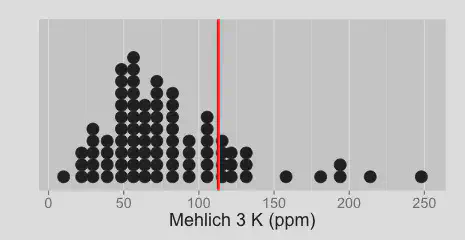
For potassium, 82% of the samples in the survey so far have been below the conventional guideline of 113 ppm.
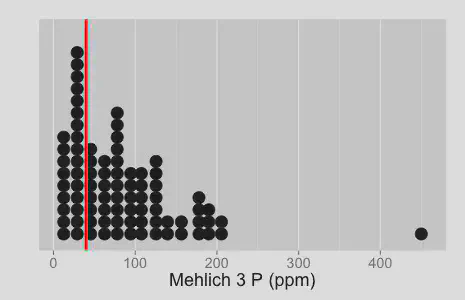
With phosphorus, it is not so bad. Only 32% of the samples are below the conventional guideline of 40 ppm.
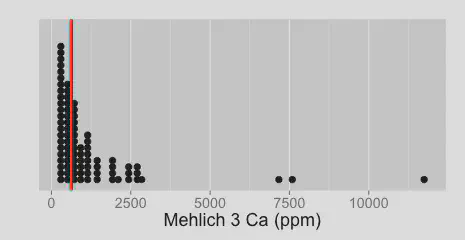
For calcium, a full 46% of the tested samples are below the conventional guideline of 625 ppm.
You can see where this leads. When the guidelines are so high, then fertilizer will tend to be recommended. And yet the turf is performing well at levels both above and below the guideline level.
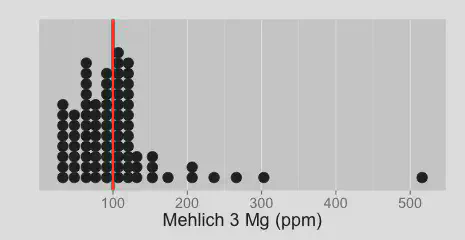
55% of the samples had magnesium below the conventional guideline of 100 ppm.
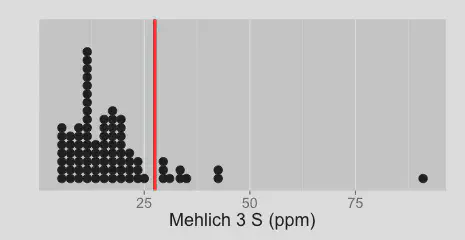
And for sulfur, 88% of the soils in the Global Soil Survey database at this time are below the conventional guideline of 27.5 ppm.
After looking at those results, we can reach one of two conclusions. First, we could say that the conventional guidelines are correct, and the soils are dangerously low in those nutrients, and we must add those nutrients. Remember, however, that these soil samples were specially selected from the locations where turf was performing well. So it seems to me that the second conclusion is the one more likely to be true. And that second possible conclusion is, the conventional guidelines are set at a level higher than is necessary to produce good turf.
This disparity between the actual nutrient levels in soils on turfgrass sites around the world, compared to the conventional guidelines, is the primary reason for our development of the MLSN guidelines.
September 2013 through August 2014. ↩︎